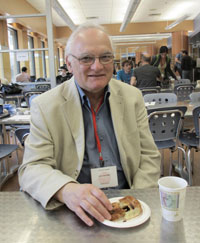By Hamish Johnston at the 2013 CAP Congress in Montreal
Jean Barrette has one of the best jobs in the world as far as I am concerned. The retired nuclear physicist is curator of the McPherson Collection of physics instruments at McGill University here in Montreal.

Jean Barrette has a great job.
This morning in the “History of Physics” session at the Canadian Association of Physicists (CAP) Congress, Jean gave a talk that featured many of the beautiful experiments – lots of brass and polished hardwood – in the collection.
The collection was made possible by the Canadian physicist Anna McPherson, who left a sizeable sum to the university when she died in 1979.
One of the highlights of the talk was what is surely the first-ever medical X-ray, which was taken in 1896 just six months after X-rays were first discovered. Taken at McGill, it shows a bullet lodged in the leg of a shooting victim.
During his talk, Jean asked for help in identifying a mysterious piece of apparatus in the collection that so far he had not been able to identify. Jean is going to send me a picture and I’ll post it in an upcoming blog entry.
The Braggs, father and son, co-winners of the Nobel Prize in 1915 for their work on X-ray crystallography, might have been first with medical use of X-rays.
From the Wikipedia article on William Lawrence Bragg (the son): “Shortly after starting school aged 5, William Lawrence Bragg fell from his tricycle and broke his arm. His father, who had read about Röntgen’s experiments in Europe and was performing his own experiments, used the newly discovered X-rays and his experimental equipment to examine the broken arm. This is the first recorded surgical use of X-rays in Australia.” It would have been before the boy’s sixth birthday (31 March 1896) and within a few months of Röntgen’s announcement of his discovery (late 1895).
Trackback: Blog - physicsworld.com